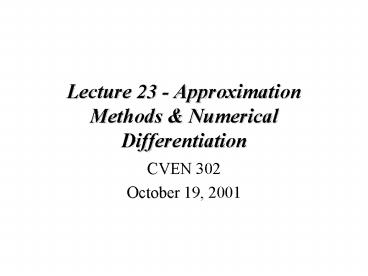Lecture 23 Approximation Methods - PowerPoint PPT Presentation
1 / 27
Title:
Lecture 23 Approximation Methods
Description:
The Tchebyshev polynomials are another set of orthogonal functions, ... The advantages for the sines and cosines are that they can model large time scales. ... – PowerPoint PPT presentation
Number of Views:27
Avg rating:3.0/5.0
Title: Lecture 23 Approximation Methods
1
Lecture 23 - Approximation Methods Numerical
Differentiation
- CVEN 302
- October 19, 2001
2
Lectures Goals
- Tchebyshev Polynomial
- Fast Fourier Transforms
- Finite Difference Schemes
- Taylor Series Expansion for Differentiation
3
Tchebyshev Polynomial
The Tchebyshev polynomials are another set of
orthogonal functions, which can be used to
represent a function as components of a function.
4
Tchebyshev Polynomial
These function are orthogonal over a range -1,
1 . This range can be scaled to fit the
function. The orthogonal functions are defined
as
5
Tchebyshev Polynomial
The Tchebyschev functions are
6
Tchebyshev Polynomial
How would you work with a least square fit of a
function.
7
Tchebyshev Polynomial
How would you work with a least square fit of a
function.
8
Tchebyshev Polynomial
The coefficients are determined as
9
Continuous Functions
Other forms of orthogonal functions are sines and
cosines, which are used in Fourier approximation.
The advantages for the sines and cosines are
that they can model large time scales. You will
need to clip the ends of the series so that it
will have zeros at the ends.
10
Fourier Series
The Fourier series takes advantage of the
orthogonality of sines and cosines.
11
Fourier Series
The time series or spatial series is generally
clipped and the resulting coefficients are
determined using Least Squared technique.
12
Fast Fourier Transforms
The Fast Fourier Transforms (FFT) are discrete
form of the equations. It takes advantage of the
power of 2 to find the coefficients in the
analysis of data. So when you hear FFT, it is
technique developed by Black and Tukey in the
early 60s. To take advantage of the computer.
It is a method to analysis the series.
13
Other Continuous Functions
Wavelets are another form of orthogonal
functions, which maintain the amplitude and phase
information of the series. The techniques are
used in data compression, earthquake modeling,
wave modeling, and other forms of environmental
loading. Etc.
14
Summary
- Modeled the equations with continuous functions
to describe the functions. - Polynomials
- Legrendre Polynomials
- Tchebyshev Polynomials
- Cosines and sines.
15
Chapter 11
- Numerical Differentiation
- Numerical Integration
16
Calculus - Numerical Methods
Differentiation
Integration
17
Numerical differentiation
- Estimate the derivatives (slope, curvature, etc.)
of a function by using the function values at
only a set of discrete points - Ordinary differential equation (ODE)
- Partial differential equation (PDE)
- Represent the function by Taylor polynomials or
Lagrange interpolation - Evaluate the derivatives of the interpolation
polynomial at selected nodal points
18
Numerical differentiation
A Taylor series or Lagrange interpolation of
points can be used to find the derivatives. The
Taylor series expansion is defined as
19
First Derivative at a Point
i-2 i-1 i
i1 i2
20
Numerical differentiation
Use the Taylor series expansion to represent
three points about single location
21
Numerical differentiation
Assume that the data points are equally spaced
and the equations can be written as
22
Forward differentiation
For a forward first derivative, subtract eqn2
from eqn1
Rearrange the equation
23
Forward differentiation
As the Dx gets smaller the error will get smaller
The error is defined as
24
Backward differentiation
Subtract eqn3 from eqn2
The error is defined as
25
Summary
- Finite Difference Technique (Taylor Series)
- Error Calculation
26
Summary
- Finite Difference Techniques
- Forward Difference Scheme
- Backward Difference Scheme
- Central Difference Scheme
27
Homework
- Check the Homework webpage































